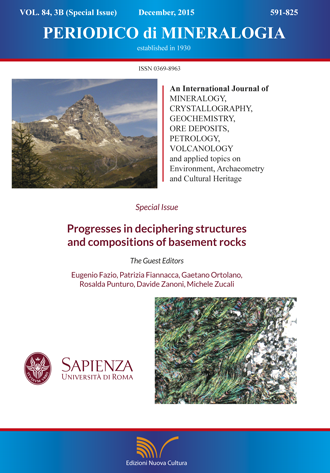High-temperature metamorphism and crustal melting: working with melt inclusions
DOI:
https://doi.org/10.2451/2015PM0434Keywords:
crustal anatexis, migmatite and granulite, peritectic phase, melt inclusions, nanograniteAbstract
The application of melt inclusion (MI) studies to migmatitic and granulitic terranes is a recent, small-scale approach for a better understanding of melting in the continental crust. In order to show the role of anatectic MI in providing a wealth of microstructural and compositional information on high-temperature metamorphism and crustal anatexis, we review a series of studies on the crustal footwall of the Ronda peridotites (Betic Cordillera, S Spain), which consists of an inverted metamorphic sequence with granulite-facies rocks showing extensive melting on top and amphibolites-facies rocks at the bottom. We studied the microstructures and geochemistry of small (2-10 µm) primary MI hosted in peritectic garnet of metatexites at the bottom of the migmatitic sequence and of diatexites close to the contact with the mantle rocks. The occurrence of MI is a proof that the investigated rocks were partially melted at some time in their history, despite other microstructures indicating the former presence of melt in mylonite were erased by deformation. MI show a variable degree of crystallization ranging from totally glassy to fully crystallized (nanogranites), consisting of Qtz+Pl+Kfs+Bt+Ms aggregates (often modal Kfs > Pl in mylonites). Piston cylinder remelting experiments led to the complete rehomogenization of nanogranites in metatexites at the conditions inferred for anatexis. Compositions of investigated MI are all leucogranitic and peraluminous and differ from those of coexisting leucosomes and from melts calculated by phase equilibria modeling. Systematic compositional variations have been observed between MI in metatexites and mylonites: the former commonly show higher H2O, CaO, Na2O/K2O and lower FeO. The compositions of MI in metatexites and mylonites are interpreted to record the composition of the anatectic melts produced from a peraluminous greywacke i) on, and immediately after crossing, the fluid-saturated solidus of this metasedimentary rock, and ii) during anatexis via biotite dehydration melting at increasing temperature, respectively. While partial melting at the bottom of the migmatitic sequence likely started in the presence of an aqueous fluid phase, MI data support the fluid-absent character of the melting event in mylonites. Anatectic MI should therefore be considered as a new and important opportunity to understand the partial melting processes.


